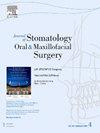Dispersed bacterial cellulose (DBC) alone graft material and adding DBC or the boric acid-absorbed DBC to xenograft increases the new bone formation during rabbit maxillary sinus augmentation- a pilot study
IF 2
3区 医学
Q2 DENTISTRY, ORAL SURGERY & MEDICINE
Journal of Stomatology Oral and Maxillofacial Surgery
Pub Date : 2025-03-28
DOI:10.1016/j.jormas.2025.102321
引用次数: 0
Abstract
This study aimed to evaluate and compare the effects of bone grafting materials, including xenograft alone, DBC alone, xenograft + DBC, xenograft + boric acid, and xenograft + boric acid-absorbed DBC, on the newly formed bone, the immune reactivity score of osteoprotegerin (OPG) and Receptor Activator Nuclear Kappa-B Ligand (RANKL) and the OPG/RANKL ratio by histological, histomorphometric and immunohistochemical analysis in rabbit maxillary sinus augmentation (MSA) model. Fourteen maxillary sinuses of New Zealand albino rabbits were augmented. Five groups were formed: xenograft alone (group1), dispersed bacterial cellulose (DBC) alone (group2), xenograft + DBC (group3), xenograft + boric acid (group4), xenograft +boric acid-absorbed DBC (group5). Eight weeks later, the species were examined. SEM, XRD, and FTIR analyses were carried out for DBC and boric acid-absorbed DBC. Inter-group comparisons were carried out by using the Kruskal-Wallis test for the immune reactivity score of OPG and RANKL and the independent sample t-test for OPG/RANKL ratio. The highest newly formed bone was observed in groups 3 and 5, and the lowest was in group 1. The percentages of newly formed bone area from highest to lowest occurred at 43.3 %, 38.3 %, 33.3 %, 30 %, and 19.5 % in groups 5, 3, 4, 2, and 1, respectively. Increased expression of OPG and RANKL was observed around newly formed bone areas in all groups. The immune reactivity score of OPG and RANKL expression was highest in group 5 and lowest in group 1, with no significant difference between the groups. The OPG/RANKL ratio was 1 in all groups, except the ratio was > 1 in only group 5, with no significant difference between the groups. The surface of DBC showed a well-organized, irregular, and interconnected porous structure. DBC found a biocompatible material. Boric acid-absorbed DBC produced a more remarkable and enlarged pore structure than DBC alone. The findings of the present pilot study indicated that DBC alone can be used as a scaffold and it seems an innovative bone graft material to filling bone defect areas that it caused enhanced bone regeneration during MSA. Moreover, adding DBC or boric acid-absorbed DBC to xenograft increased newly formed bone significantly.
分散细菌纤维素(DBC)单独移植物材料和添加DBC或硼酸吸收DBC的异种移植物增加新骨形成骨在兔上颌窦增强过程中的初步研究。
本研究旨在通过组织学、组织形态学和免疫组化分析,评价和比较异种移植物单独、DBC单独、异种移植物 + DBC、异种移植物 + 硼酸和异种移植物 + 硼酸吸收DBC对兔上颌窦增强(MSA)模型新生骨的影响,以及骨保护素(OPG)和受体激活物核κ b配体(RANKL)的免疫反应性评分和OPG/RANKL比值。扩增了14只新西兰白化兔的上颌窦。组成5组:单独的异种移植物(组1),单独的分散细菌纤维素(DBC)(组2),异种移植物 + DBC(组3),异种移植物 + 硼酸(组4),异种移植物+硼酸吸收DBC(组5)。八周后,对这些物种进行了检查。对DBC和硼酸吸附DBC进行了SEM、XRD和FTIR分析。OPG和RANKL免疫反应性评分采用Kruskal-Wallis检验,OPG/RANKL比值采用独立样本t检验进行组间比较。3、5组新生骨最多,1组新生骨最少。5、3、4、2、1组新生骨面积百分比由高到低分别为43.3%、38.3%、33.3%、30%、19.5%。各组新生骨区周围OPG和RANKL表达均升高。OPG和RANKL表达的免疫反应性评分以组5最高,组1最低,组间差异无统计学意义。各组OPG/RANKL均为1,除第5组OPG/RANKL为>.1外,各组间差异均无统计学意义。DBC表面呈有序、不规则、相互连接的多孔结构。DBC发现了一种生物相容性材料。硼酸吸附的DBC比单独的DBC产生更显著和更大的孔结构。本初步研究结果表明,DBC可以单独用作支架,它似乎是一种创新的骨移植材料来填充骨缺损区域,它可以增强MSA期间的骨再生。此外,在异种移植物中加入DBC或硼酸吸收DBC可显著增加新生骨。
本文章由计算机程序翻译,如有差异,请以英文原文为准。
求助全文
约1分钟内获得全文
求助全文
来源期刊

Journal of Stomatology Oral and Maxillofacial Surgery
Surgery, Dentistry, Oral Surgery and Medicine, Otorhinolaryngology and Facial Plastic Surgery
CiteScore
2.30
自引率
9.10%
发文量
0
审稿时长
23 days
 求助内容:
求助内容: 应助结果提醒方式:
应助结果提醒方式:


